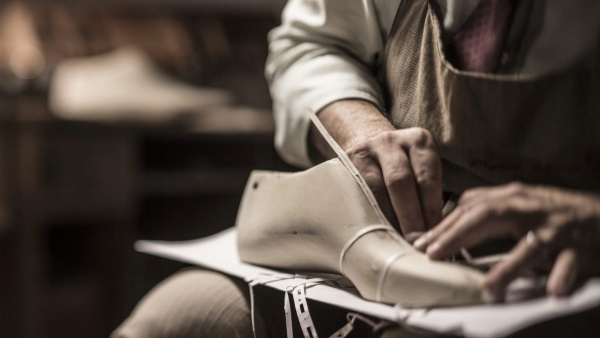It is not by chance, this ability derives from our history, our culture, our “land”. Italian craftsmanship is the result of experiences, cultures and knowledge rooted in the country’s history and is synonymous with quality, passion, care, innovation, style, in one word “excellence”. Halfway between art and technique, experience and imagination, handmade objects, unique and special, are undoubtedly more fascinating; the human beings and their skills are at the centre of their production process, filtering the innovative and creative capacity of the individual through the knowledge passed on across generations.
From the artisanal utensils of mountain areas to the tapestries that decorated the court palaces of Europe, Italian artisans knew, and still know, how to transform the most diverse raw materials, from wood to marble, from glass to textiles, into a wide range of realizations where, sometimes, craftsmanship becomes art.
The words "arte" (art) and "artigiano” (craftsman) come from the Latin "ars", which means "practical or technical method". In the Middle Ages in Europe, to indicate a craftsman they used the word "artista” (artist) but not the word “artigiano” and the craftsman’s social relevance was very high, although there was no word to identify him. He was considered a person who excelled in his craft, in his art, just like an artist.
Becoming a craftsman was very difficult, they had to work hard for a long time. There were several and numerous associations of craftsmen. Children chose the one dealing with their preferred matter (painting, sculpting, carving….) and started as apprentices. Later on, they entered a "Bottega", where an experienced craftsman (today’s tutor) began to teach them the secrets of the job. At the Bottega, “il Maestro”, the owner of the shop, dealt with customers, decided which works to execute and designed them; then several aides, apprentices or associates, worked together with him or upon his instructions. At the end, when the work was very important or the customer very illustrious, the “Maestro” alone would refine it and complete the most difficult details.
 As apprentices, the young students just observed, trying to understand and learning the dynamics of the workshop's work. Over time, they learned more and more about materials, instrumentation, processing techniques and now and then they were actively involved. In the beginning, no pay; they could get a little pay only when their production standards met fixed quality targets set by the Guild. Only after the internship period, they could become “associate” or “companion”: they could work with the Maestro until they could get the necessary tools to start their own entreprise. Finally, they could own a workshop and become “Maestro” themselves, but only after passing an exam, to be held at the Guild’s house.
As apprentices, the young students just observed, trying to understand and learning the dynamics of the workshop's work. Over time, they learned more and more about materials, instrumentation, processing techniques and now and then they were actively involved. In the beginning, no pay; they could get a little pay only when their production standards met fixed quality targets set by the Guild. Only after the internship period, they could become “associate” or “companion”: they could work with the Maestro until they could get the necessary tools to start their own entreprise. Finally, they could own a workshop and become “Maestro” themselves, but only after passing an exam, to be held at the Guild’s house.
These associations, called “Corporazioni delle Arti e dei Mestieri” (Arts and Crafts Guild), were very organized. Every aspect was regulated, from raw materials to working processes. The craftsmen were protected by their Corporation, which fought harshly against fakes (hence the word "rule of art"). Each
Guild had a patron saint with its church or at least a chapel; on the day dedicated to the Guild’s patron, the affiliates paraded with their banners.
The artisans lived all in the same area, and this has also left its mark in the place names of Italian cities: from Via dei Calzaioli in Florence (Calzatura meaning shoe in English) to Via degli Orefici in Bologna (the Street of Goldsmiths). In Venice, the “Scuola dei Calegheri" (the School of cobblers) was established in the 12th century and in 1293 in Florence cooks, shoemakers and saddlers were already included among minor arts.
In many cases, an industry originated from these traditions. This is the case, for example, of the silk industry in the Como area or the goldsmith district in Valenza Po, between Alessandria and Pavia, while Montebelluna near Treviso is the world capital of mountain shoes. Acclaimed brands such as Borsalino (hats) and Marinella (ties) were born from small artisan workshops and are now recognized all over the world.
In other cases, techniques and experiences were passed on from father to son across decades, keeping ancient production methods alive for centuries: the goldsmith tradition in Taranto dates back to the Greek era, the process of felting the wool and thus making “loden” comes from an ancient technique developed by Tyrolean mountaineers, while in Sicily the art of ceramics dates back to the 5th century BC at least.
 The demand for fine goods by the European courts and, since the 19th century, the upper bourgeoisie was another great boost for quality artisanal production. The rich Florence of the 15th century, a true forge of creativity, was the cradle of wooden “tarsia”, with 84 carving shops. The district of the fine ceramics of Capodimonte, in the Naples area, was started in the mid-1700s by King Charles of Bourbon to rival French production. Lace developed on the island of Burano, near the thriving Venice (while in nearby Murano the crafts of glass flourished); in its many regional variants, it adorned the clothes of the nobility and bourgeoisie of half Europe: for its coronation King Louis XIV, the “Sun King”, wore a fine collar of Burano lace.
The demand for fine goods by the European courts and, since the 19th century, the upper bourgeoisie was another great boost for quality artisanal production. The rich Florence of the 15th century, a true forge of creativity, was the cradle of wooden “tarsia”, with 84 carving shops. The district of the fine ceramics of Capodimonte, in the Naples area, was started in the mid-1700s by King Charles of Bourbon to rival French production. Lace developed on the island of Burano, near the thriving Venice (while in nearby Murano the crafts of glass flourished); in its many regional variants, it adorned the clothes of the nobility and bourgeoisie of half Europe: for its coronation King Louis XIV, the “Sun King”, wore a fine collar of Burano lace.
But Italian craftsmanship was not just making luxury goods for the ruling classes: instead, its creations have been fundamental in the popular culture and traditions of the whole country. Lace, belts, hats and leather embroidered trousers embellish festive dresses in Alpine areas. The "presentosa" is an unmissable jewel in weddings across Abruzzo. The renowned manufacture of Sardinian knives was primarily used by sheperds in the countryside. And in artisanal productions across Italy we can find the influence of the foreign peoples we came in contact with: from the Greek and Eastern influence on ceramic decorating techniques to the Albanian influence in the jewels of Basilicata and Calabria.
Talking about craftsmanship means talking about territories and how the people living there interpret them. Sometimes the territory is the source of extraordinary raw materials, such as Carrara marble (used by Michelangelo for its famous statues, the David above all) or the wood of Trentino - South Tyrol, used by sculptors but also by violin makers (Stradivari). Craftsmanship excellence stands even when the source of raw materials has run out or proved inadequate to consumers’ new needs. In other cases, being on a trade route gave access to exotic raw materials, which local artisans used creatively, or to international sales channels, much more profitable than the local ones for the most valuable goods, such as the cameos of Torre del Greco, close to Naples.
 So, follow us on a fascinating and amazing journey along the peninsula, in search of Italian artisanal excellence: ceramics and terracotta, hide and leather, metal, wood, marble and stone works, fabrics, lace and embroidery, glass and mosaics. It is the truest, most artistic, most ingenious Italy.
So, follow us on a fascinating and amazing journey along the peninsula, in search of Italian artisanal excellence: ceramics and terracotta, hide and leather, metal, wood, marble and stone works, fabrics, lace and embroidery, glass and mosaics. It is the truest, most artistic, most ingenious Italy.
Next stop: hide and leather.

